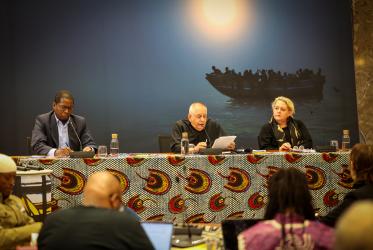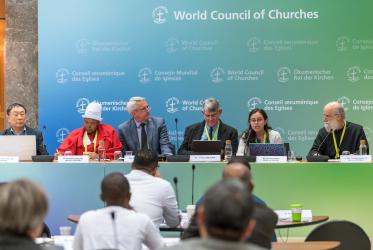Pastoral letter on HIV/AIDS and the response of the church
December 2003
The Catholic Bishops of Myanmar have written a Pastoral Letter on HIV/AIDS and the Response of the Church to all Priests, Religious and Faithful in Myanmar. The following are some extracts from the Bishops' letter:
Myanmar is among the countries of South East Asia that are affected by HIV. Although the incidence of infection varies widely between different States, no area of the country is free of HIV. Thus to a greater or lesser extent all dioceses are affected by HIV. The virus has no respect for age, gender, ethnicity or religious belief. All communities within Myanmar, rural and urban, Christian, Buddhist, Animist and those of no religious belief are all affected. The immediate vectors of infection are well identified: blood, sexual fluids and breast milk. The underlying causes of infection for the majority of people in Myanmar are linked to poverty and powerlessness.
Challenges and Opportunities for the Catholic Church in Myanmar: the Church is in a privileged position of being able to reach people worst affected by HIV, in villages and towns where, often, no NGO has access and where locally-based or government led HIV-related care and prevention programmes are non-existent. Church personnel have the potential to provide at least basic care and support for people infected and affected, to educate about the infection and how it can be prevented, and to reduce the stigma and discrimination suffered by people infected and affected by HIV. HIV raises one of the biggest taboo subjects: sex. Thus open discussion of sexual health and sexual behaviours is difficult. Within church circles this taboo may be stronger. (The Letter goes on to highlight the needs of both those infected and affected by HIV and AIDS.)
How can the Church Respond? All who hold positions of leadership in the Church (bishops, priests, religious, catechists and lay leaders) need to be well informed about HIV and also about the ethical and moral questions raised by HIV. In every diocese, the Church must look to support all those within their geographic region who are affected by or vulnerable to HIV, and not just to Catholics or Christians. Bishops and priests are public figures in the communities they serve, they can lead by example in what they say and in what they do, for example:
-
Every Sunday, priests and bishops have an opportunity to speak out. They can use their sermons to condemn any form of discrimination against people affected by HIV, to educate their communities about HIV and AIDS, and to address some of the root causes of infection in Myanmar.
-
Bishops and priests can make sure that they and their parishioners are not judgemental in their words or actions, and that people living with HIV and their families are always welcome in the liturgies and wider activities of their Church communities.
-
Bishops and priests can encourage the diocese to seek alternative employment opportunities for young men and women whose present work options heighten their vulnerability to HIV.
-
Bishops and priests can visit people sick with AIDS, bringing them the sacraments and offering support to them and their families.
-
Bishops and priests can enable and encourage the HIV-related work of sisters and lay catechists. There are many examples where clergy say, "our people don't need to know about HIV/AIDS", or "our people would be scandalised if we talked about sex". In other instances, priests or bishops have stopped lay people from raising awareness about HIV, telling them they are not qualified to discuss these moral questions and even preventing them from giving scientifically proven sexual health information about HIV prevention. Such negative attitudes need to change if the Church is to offer any meaningful response to HIV/AIDS.
-
Bishops and priests can work in collaboration with leaders of other Christian churches and other faiths to offer a united response to the epidemic.
We are aware of the magnitude of the task ahead of us. We share a common ideal with all who are working to eliminate the stigma and discrimination attached to HIV and we know that it is only through our mutual collaboration that we can realise the World AIDS Day Campaign aspiration to "Live and Let Live".
The letter then goes on to request all parish clergy to offer prayers in their parishes on Sunday December 7th for all who are living with HIV and AIDS. They also suggest some special prayers which might be used.
Pastoral letter on HIV/AIDS and the response of the church
December 2003
The Catholic Bishops of Myanmar have written a Pastoral Letter on HIV/AIDS and the Response of the Church to all Priests, Religious and Faithful in Myanmar. The following are some extracts from the Bishops' letter:
Myanmar is among the countries of South East Asia that are affected by HIV. Although the incidence of infection varies widely between different States, no area of the country is free of HIV. Thus to a greater or lesser extent all dioceses are affected by HIV. The virus has no respect for age, gender, ethnicity or religious belief. All communities within Myanmar, rural and urban, Christian, Buddhist, Animist and those of no religious belief are all affected. The immediate vectors of infection are well identified: blood, sexual fluids and breast milk. The underlying causes of infection for the majority of people in Myanmar are linked to poverty and powerlessness.
Challenges and Opportunities for the Catholic Church in Myanmar: the Church is in a privileged position of being able to reach people worst affected by HIV, in villages and towns where, often, no NGO has access and where locally-based or government led HIV-related care and prevention programmes are non-existent. Church personnel have the potential to provide at least basic care and support for people infected and affected, to educate about the infection and how it can be prevented, and to reduce the stigma and discrimination suffered by people infected and affected by HIV. HIV raises one of the biggest taboo subjects: sex. Thus open discussion of sexual health and sexual behaviours is difficult. Within church circles this taboo may be stronger. (The Letter goes on to highlight the needs of both those infected and affected by HIV and AIDS.)
How can the Church Respond? All who hold positions of leadership in the Church (bishops, priests, religious, catechists and lay leaders) need to be well informed about HIV and also about the ethical and moral questions raised by HIV. In every diocese, the Church must look to support all those within their geographic region who are affected by or vulnerable to HIV, and not just to Catholics or Christians. Bishops and priests are public figures in the communities they serve, they can lead by example in what they say and in what they do, for example:
-
Every Sunday, priests and bishops have an opportunity to speak out. They can use their sermons to condemn any form of discrimination against people affected by HIV, to educate their communities about HIV and AIDS, and to address some of the root causes of infection in Myanmar.
-
Bishops and priests can make sure that they and their parishioners are not judgemental in their words or actions, and that people living with HIV and their families are always welcome in the liturgies and wider activities of their Church communities.
-
Bishops and priests can encourage the diocese to seek alternative employment opportunities for young men and women whose present work options heighten their vulnerability to HIV.
-
Bishops and priests can visit people sick with AIDS, bringing them the sacraments and offering support to them and their families.
-
Bishops and priests can enable and encourage the HIV-related work of sisters and lay catechists. There are many examples where clergy say, "our people don't need to know about HIV/AIDS", or "our people would be scandalised if we talked about sex". In other instances, priests or bishops have stopped lay people from raising awareness about HIV, telling them they are not qualified to discuss these moral questions and even preventing them from giving scientifically proven sexual health information about HIV prevention. Such negative attitudes need to change if the Church is to offer any meaningful response to HIV/AIDS.
-
Bishops and priests can work in collaboration with leaders of other Christian churches and other faiths to offer a united response to the epidemic.
We are aware of the magnitude of the task ahead of us. We share a common ideal with all who are working to eliminate the stigma and discrimination attached to HIV and we know that it is only through our mutual collaboration that we can realise the World AIDS Day Campaign aspiration to "Live and Let Live".
The letter then goes on to request all parish clergy to offer prayers in their parishes on Sunday December 7th for all who are living with HIV and AIDS. They also suggest some special prayers which might be used.





